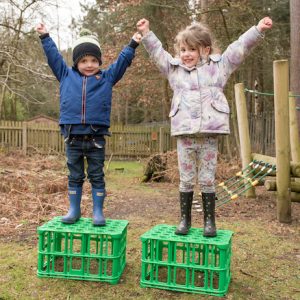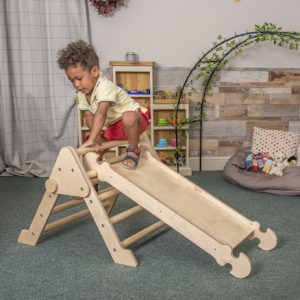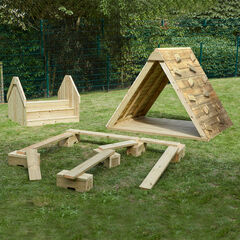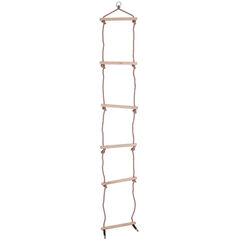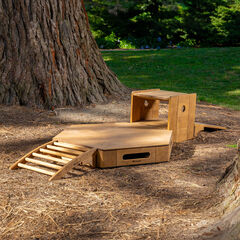Developing a lifelong love of movement
Movements such as jumping and climbing are important for children and include many benefits. I genuinely believe that we all have a responsibility to provide opportunities to engage in physical activity, to enjoy active play and to develop a love of moving.
If we do this, we set children on the path to a lifelong love of movement. This is better for emotional, mental and physical wellbeing and is a cradle to grave concept.
Research from the British Heart Foundation shows that physical activity levels in children track through time, so the more active they are in their early years, the more likely they are to be active as they get older.
Part of developing this lifelong love of movement is to provide a breadth of opportunities indoors and outdoors, to experience all the joys movement can bring. In this blog I’ll focus on the physical development benefits climbing can bring, not for any other reason than it is often overlooked and sometimes feared, but is a truly beneficial activity for children and adults of all ages.
Want to hear more about how a setting added climbing opportunities into their indoor environment? If so, click on the video below.
Should we worry about children climbing?
Let’s think about what ‘climbing’ is. You only need to Google it and I can see where maybe the fear comes from!
“The sport or activity of climbing mountains or cliffs” or “The sport of climbing on rocks or in mountains, or on specially designed walls inside or outdoors.”
But in a nutshell climbing is simply:
“The activity of using one’s hands, feet, or any other part of the body to ascend an object. This can be indoors and out, on natural and man-made structures.”
That certainly sounds less scary to me than the other descriptions!
Opportunities for climbing
So take a moment to reflect on what opportunities for climbing exist for the children you care for. Are there slopes, slides, climbing frames or mini ladders? Or do you have a combined climbing structure with different opportunities all-in-one? Where are these opportunities? Outdoors? Indoors? Both? How do you manage the risk versus opportunity dilemma?
Managing the risk of climbing
Manage the risk in the same way you do with all other activities. If in a setting, check your policy, undertake risk assessments where necessary and provide appropriate adult supervision. Bear in mind, climbing can happen on very shallow slopes too! And now let’s focus on physical development and how climbing can help children thrive.

Climb to thrive – The benefits of climbing
So let’s take a look at the benefits of climbing for children and the skills they develop. Agility, Balance and Coordination are the fundamental movement skills we seek to develop in our children from the earliest opportunity. They are easy to remember as the A, B, Cs of movement. When children have a solid foundation of these movement skills, the world of physical activity and sport opens up to them, as they grow and develop. This enables children to:
- Make choices about what they want to try
- Helps them to gain the confidence to have a go
- Supports social skills as they engage and are active with and alongside others.
The Outdorable range is a great way to encourage these key skills. To find out more, read our blog, ‘Physical Development Outdoors: Why Choose Outdorable‘.
Thinking about agility
Thinking about agility, climbing provides many opportunities. These include:
- Travelling opportunities in different directions such as forwards, backwards and sideways depending on the equipment.
- Climbing can engage the body in different speeds of movement and, also different ways of travelling such as crawling on hands and knees, bear crawling on hands and feet or maybe tummy sliding.
- It supports coordination, cross lateral movements, hand to eye, and hand to foot coordination.
Thinking about balance and coordination
When referring to balance, I feel it’s important to think more broadly than a simple standing or seated balance, think about core stability. It is the strength in the core that enables us to sit up, to stand up, to reach, stretch and twist. Crucially there is also a link between core stability and focus and concentration. The benefits are huge, climbing engages the core with every stretch, reach, twist turn, or body controlled movement.
When we observe children climbing, they will use their arms and legs to push and pull, most often using opposite leg to opposite arm. A complicated move, but important in developmental terms, firing up both sides of the brain reinforcing the connections in the brain.
Climbing provides children with the opportunity to use gross and fine motor skills. Fingers are used to grip the sides of slides/slopes, handles or rungs. Gripping and releasing helps to strengthen fine motor skills. Using hands to help pull the body upwards, supports this too. And let’s not forget the feet, with all those 1000s of nerve receptors, bare foot climbing will provide rich sensory experiences too!
Creating climbing opportunities may take a little planning, maybe a little rearranging of equipment or some encouragement to motivate the children to climb. But it really is worth it.
Learn more about our climbing range
Many thanks to Philippa Youlden for writing this blog for us.
Philippa Youlden is a freelance PE, sport, wellbeing and education consultant. She is passionate about the power of movement, activity, high quality PE and school sport opportunities for all children.

